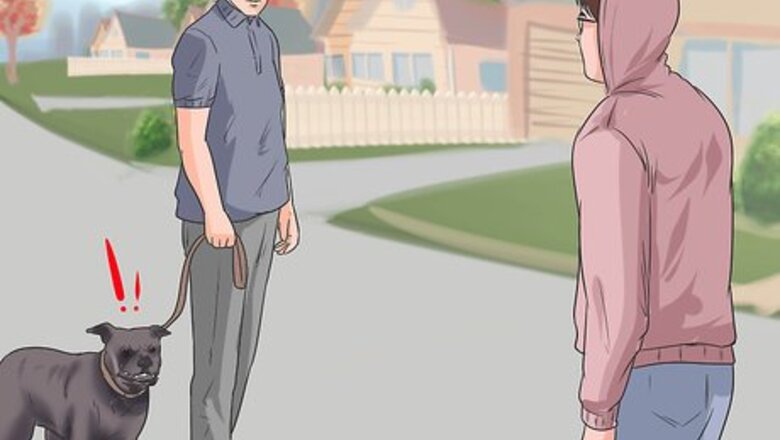
views
Acclimating Your Dog to Strangers
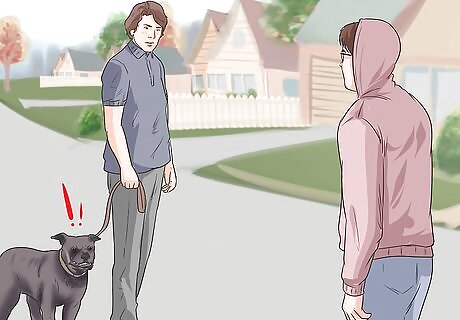
Notice any people your dog dislikes. Your dog may react negatively to certain groups of people, including men, women, people of color, or even people in hats. If you notice which groups your dog reacts negatively towards, you can try to change this negative association for your dog. Your dog may have many reasons for this negative association. If you got the dog from a shelter or as an adolescent, they may have had bad experiences in the past with specific groups of people. Additionally, your dog may not have had a lot of exposure to a specific group of people, so they are fearful of unknown people. Getting them more exposure to different groups of people is the best way to make them less fearful.
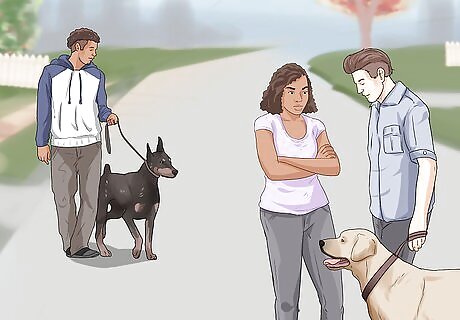
Expose your dog to a wide variety of people. If you find your dog is fearful or dislikes men, women, or people of color, it's a good idea to expose your dog to some of these different groups. You'll want this to be in a safe setting where your dog feels comfortable. You can invite friends that are members of different groups your dog dislikes over to your house. Keep your dog on a leash at all times so you can control them. Have your friends offer treats to your dog whenever the dog is behaving well towards them. Once your dog begins to affiliate treats with strangers, they will begin to get over their fear and dislike. Never give a treat while the dog is actively growling or being aggressive, as this rewards the bad behavior and also strengthens it.
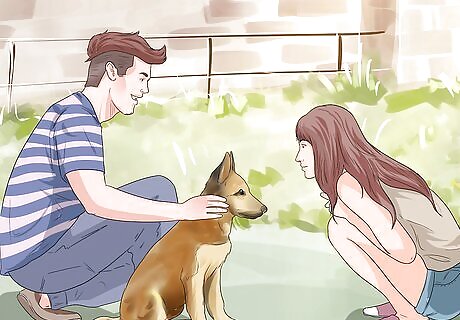
Invite close friends over to meet your dog. Dog can be easily overwhelmed with too many people. If you can introduce your dog to a few new people in a controlled environment, they can learn that people are not scary, but can be good and friendly. When your friends come over, give them treats or dinner to give to your dog. If possible, see if your dog will take their dinner or treats from your friend. It’s important to keep your dog on a lease. They may get frightened and lash out, so you want to be able to control their movements in case this happens.

Associate yourself with strangers. Your dog should trust you, so if you are friendly towards others, your dog should learn that they should be friendly towards those people as well. Even something as simple as sitting and talking to others while your dog watches can be useful to get them over being aggressive towards strangers. Sitting and talking quietly with other people makes your dog think of them as not being a threat. They may bark or seem aggressive at first, but if you ignore them, your dog will eventually learn that this specific stranger is not a threat to you or them. While you’re talking to other people, you can have treats at your feet. If your dog approaches, they get the treat, while if they are too afraid they will not.
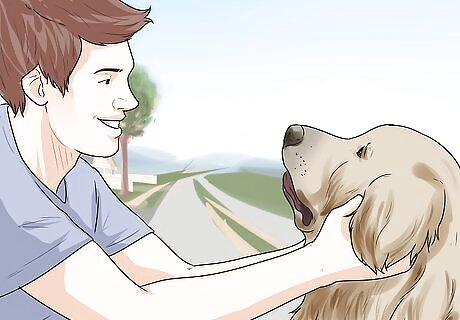
Reward your dog for meeting new people. When you invite people over, you want your dog to not be aggressive or hostile towards others. Giving them treats when they are nice, even if they are not especially friendly, can get them to be more open towards meeting others. When your first introduce your dog to a new person, give them a treat if they don’t bark. Even saying things like “good boy” or “good girl” if they don’t bark can be a good first step. If possible, see if your dog will take the treat from the new person. However, it’s important to know your dog’s signs of aggressive so they don’t bite or lash out rather than taking the treat gently from the stranger.
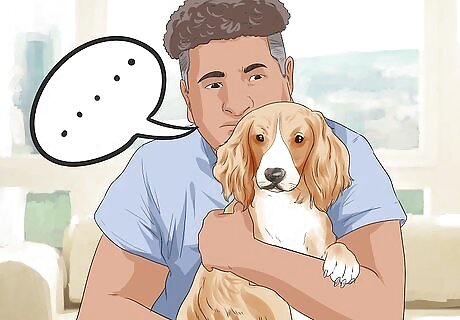
Talk to your dog before they meet others. Speaking in a friendly tone of voice can get your dog to be friendlier towards other people. If your dog begins acting out or acting aggressively towards others, speaking in a firm and lower tone of voice will get them to pay attention and listen to you. When you're socializing your dog around a few other people, speaking in a pleasant and excited tone of voice should get your dog to also be pleasant or excited. Once they associate your happiness with the other person, they should realize there is no threat. If your dog looks anxious or looks like they may get aggressive, speak in a firm tone of voice. This will let them know you mean business and that they need to obey you.
Introducing Your Dog to Strangers

Take your dog for a walk at a distance from others. Your dog may get overwhelmed around too many strangers. Instead, take your dog for a walk where they can see strangers, but are not too close to them. Your dog may be curious about other people in the distance. If their curiosity seems pleasant, but not anxious, then maybe you can walk closer to other people. It's important to take some time for your dog to get used to being close to strangers. They may not seem ready to be near others; if this is the case, don't force them to meet new people just yet. Keep the dog at a distance from you, oftentimes keeping the dog close or holding the collar/leash tightly can cause the dog to feel they need to protect you from other humans and animals.
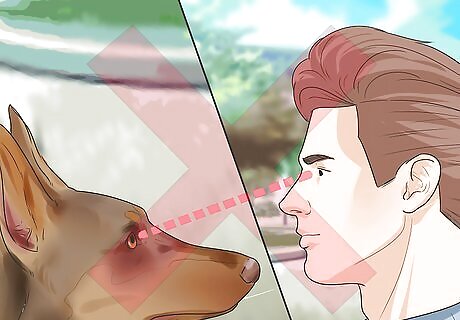
Don't have strangers approach the dog directly or make eye contact. Dogs may take both of these things as signs of potential aggression. They may get nervous and dislike the stranger before even meeting them. If you know the new people your dog is meeting, ask them to avoid eye contact. Eye contact for dogs can meet a fight for domination, depending on the circumstances. Having the stranger approach your dog from an angle is also a good idea.This way your dog will not see them as a threat or be surprised by their appearance.
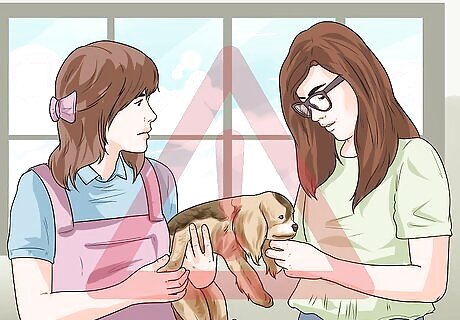
Be cautious if others want to pet your dog. When you're in public, some people may want to pet your dog, so it's important to know your dog's reaction. If your dog is likely to be aggressive if being pet by strangers, tell others that your dog does not like to be petted. If someone wants to pet your dog, ask them to put their hand out palm first. This allows your dog to sniff the other person and determine how they feel about them. Your dog may only like to be petted in certain areas and in certain ways. Tell strangers where and how to pet your dog.
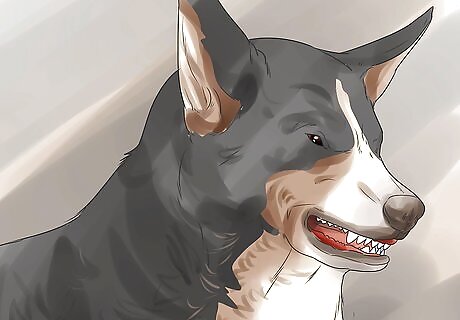
React immediately if your dog bites. Dog bites can be serious, especially since the most common people bitten by dogs are often children. If your dog does bite a stranger, react immediately to remove your dog from the situation. Dogs have a few obvious warning signs when they are about to bite. They may pin their ears back, yawn, or their fur may stand up on their back. If you see any of these warning signs, remove your dog immediately. If your dog bites, pull your dog out of the area using their leash. Remove them from the area so they do not get excited again.
Recognizing Your Dog’s Emotional Response to Strangers

Look for signs of anxiety or nervousness. Dogs give off clear physical signs of anxiety or nervousness. If you notice your dog doing any of these things, get them away from strangers, since they are feeling anxious or stressed. Dogs that lick their nose and lips are feeling anxious. Additionally, a "stress yawn" is common in dogs that feel nervous. Panting or pinned ears can be a sign of nerves. While dogs do pant when they are overheated, they may also pant when they don't feel comfortable.
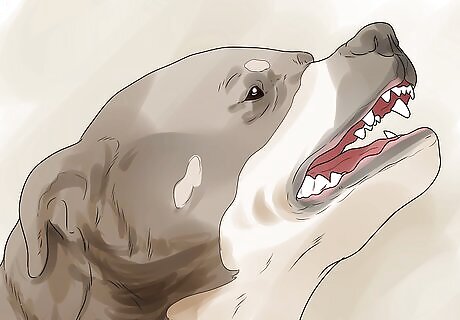
Notice physical signs of aggression. Before a dog is about to become aggressive, they give off signals that tell you how they feel. Usually, this will come after their signs of anxiety, though the two are also largely interchangeable. If your dog becomes very rigid and stiff, they are feeling threatened. Their tail will also be rigid and not wagging comfortably about. Any growling or showing of teeth is usually a sign of aggression. Growling that is low is a clear sign your dog feels threatened.
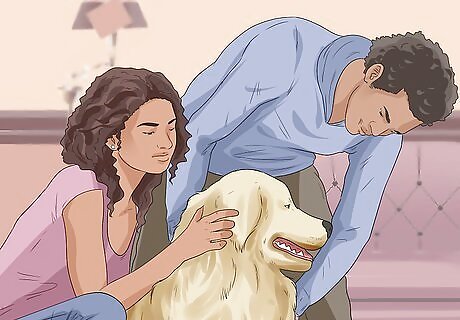
See if your dog is happy or comfortable around strangers. Dogs also give clear signs when they feel good around strangers. Their body language and behavior will tell you a lot about how your dog is feeling towards others. Dogs show their emotions through their tail and their eyes. If they are wagging their tail loosely and making friendly eye contact, they likely feel good around other people. An especially happy dog will roll over and allow you to pet its stomach. Belly rubs show that the dog is trusting and willing to be put in a vulnerable position around you.




















Comments
0 comment